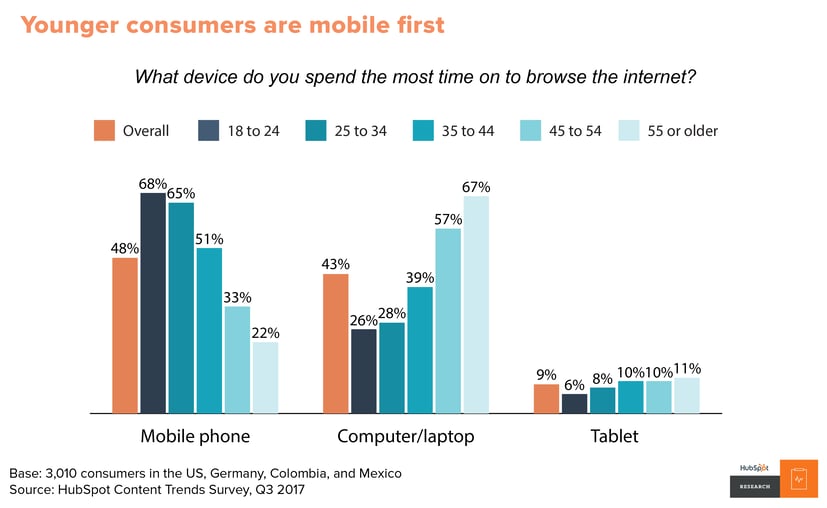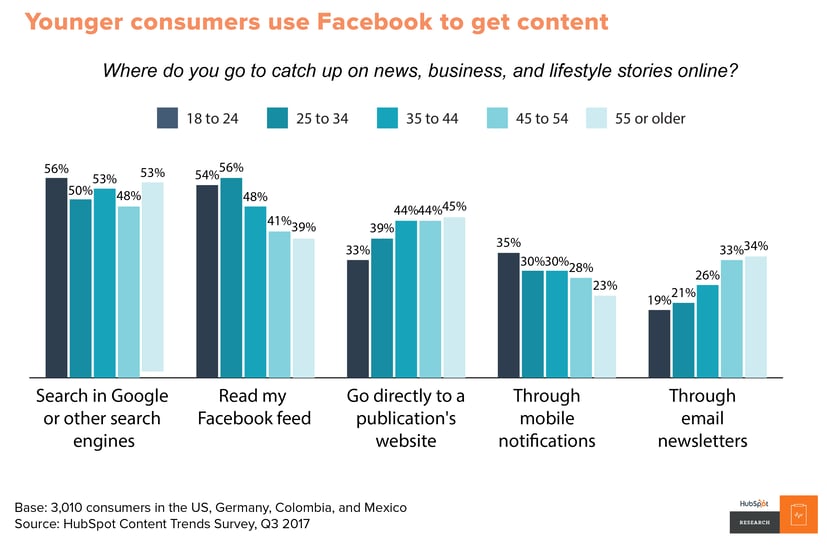If you think video content is taking over the world, you are correct. HubSpot recently conducted a study to find which types of content and channels attract consumers. HubSpot questioned over 3,000 consumers during this study and their research shows that content consumption is very dependent on age.
If age determines how content is delivered and where it is published, then why is video the future of content? Also, are the rumors true, is email dead? Well, those pesky millennials are now adults using social media platforms and mobile devices to communicate. However, millennials aren't only using their phones to post pictures to Facebook, they increasingly use mobile and social platforms to make business decisions.
Bridge the Content and Age Gap
What devices are we using?
There are many behavioral differences between Millennials, Gen Xs, and Baby Boomers, including how they all consume content. For instance, Millennials and Boomers do not search for information on the same device and when they are looking for information, they prefer consuming content in different formats.
HubSpot's research found that Millennials use their phones to search at a higher volume than any other generation. In fact, 68% of people between the ages of 18-24, and 65% of people between the ages of 25-34 agreed that they spend the most time on mobile devices to browse the internet. In contrast, only 33% of people between the ages of 35-44, and 22% of people 55 or older agree with millennials when it comes to mobile search.

Where are we searching?
Along with difference in devices, there is also a stark difference in where people go to find content. Facebook is no longer used just to catch up with friends, it has become a huge channel for content distribution and consumption. Many users still rely on Google to find the content that they are looking for, but Facebook passively feeds you content you aren't actively seeking.
Google is adapting to the way people discover products and trends. Many still rely on Google to find content, but Facebook is now nearly as influential as Google. - Mimi An, HubSpot Contributor
Instead of intentionally searching for a specific piece of content, Facebook presents content based on your friends, your past Google searches, and business pages that you like. This method of content consumption has become so effective that even Google now mimics it. Using Google on a mobile device allows users to see a newsfeed of information relevant to previous searches and self-identified demographics, just like your Facebook newsfeed.
HubSpot's research shows that 54% of people between the ages 18-24, and 56% of people between the ages 25-34 read their Facebook feed to catch up on news, business and lifestyle stories. On the other hand, 41% of people between the ages of 45-54, and only 39% of people 55 and older go to their Facebook newsfeed to catch up on the news, business, and lifestyle stories.
Nevertheless, not everyone is heading to Facebook for content. The table turns when you look at the percentage of people who go directly to publication's websites to catch up on the news, business, and lifestyle stories. Only 33% of people 18-24, and 39% of people 25-34 go directly to publication websites to find the content they want. However, 44% of people between the ages of 45-54, and 45% of people 55 and older go directly to a publication's website to find desired content.

What type of content are we consuming?
Video vs. Email
Video is here and it is dominating the playing field. Facebook, Instagram, YouTube, Twitter, Blogs, News/Sport/Entertainment sites, even animated business sites are all using video to attract and engage visitors, and it works. It works so well that major content-centric companies are creating entirely new departments for video creation and distribution.
.@johnjohnflorenc from the water 📹 pic.twitter.com/KfNzVCFAbX
— World Surf League (@wsl) November 23, 2017
Video works because it is more effective than written or audio based content. Video traps your full attention and is more entertaining than just audio content. Video can also be used to support written content or vice versa. Video also can live on multiple platforms simultaneously without changing major aspects of it, unlike written content. There is no need to change time limits from platform to platform (unless you are using Instagram), unlike the character count and different Title/descriptions lines from Facebook to LinkedIn to Twitter.
Video content is versatile, engaging, and easy to absorb, which is why it is dominating social platforms and websites today, but, just like everything else, this does not mean that everyone agrees, or is partial to video becoming the standard content format.
Email content, research reports, and news articles are all types of content that the Baby Boomer generation prefers over video.
What does all of this mean for marketers in 2018?
Balance is key. As marketers, we need to understand the ongoing shift from Baby Boomers and Gen Xs with buying power to Millennials. This means that email marketing, whitepapers, and news articles should still be curated and distributed through email lists and promoted on different social sites. We do not want to abandon the GenX or Baby Boomer populations, especially since they are in a position to make and influence their company's decisions.
However, as time goes on Millennials will be making the majority of purchasing decisions for their employers and that means that marketers need to reach them where they live. This means we should be adopting video content practices and implementing the distribution of video content to social platforms now. Video content is the future and email marketing will still be relevant for years to come. The way marketers create and use content will never be stagnant, but our goal to engage and nurture leads will remain constant. It is up to marketers to tweak the tools at our disposal to entice and inform our audience.
In 2018, marketers should focus on establishing an educational foundation surrounding video and the technology needed to produce it. This doesn't mean you need a video crew and production team, most of us have the capability to shoot video in our pockets. Once have this base, look at your audience and decide which segment should receive more traditional content via email and which segment should start being delivered video content.
Most importantly, be sure to test everything. Continue to message your email segment, but add embedded video and measure the results. This may prove to be effective, or it may not. Every audience for every business is unique, so one approach won’t apply to everyone, but what we are learning is that video is here to stay, we just need to find the best way to use it.
Written December 7, 2017 by
Frank "Pickle" Pickel
Marketing Maestro with a hint of savvy syntax. Five-year plan: Mick and I are going to wing on over to London and jam with the Stones!